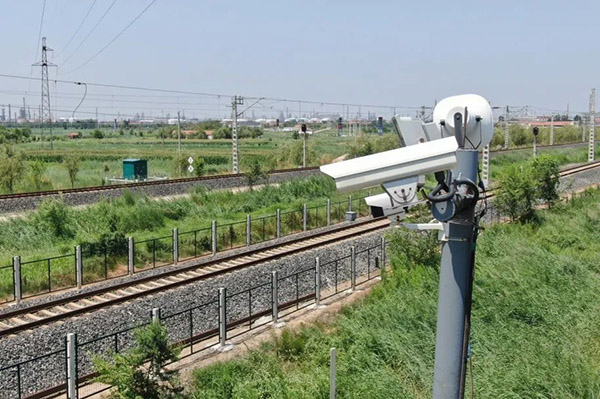With the continuous development and modernization of the railway system, the importance of the railway comprehensive video monitoring network is becoming increasingly prominent. This network plays a crucial role in ensuring train safety, facility status monitoring, and emergency response. This article will delve into the new applications of industrial Ethernet switches in railway integrated video surveillance networks and how they lead technological innovation in this field.
1. Characteristics of Railway Integrated Video Surveillance
The video monitoring system of railways requires the use of advanced video monitoring technology, based on the IP network of the railway system, to build a digital, intelligent, and distributed network video monitoring system, meeting the needs of various business departments such as public security, case management, passenger transportation, scheduling, vehicle maintenance, maintenance, public affairs, electrical services, vehicles, power supply, as well as disaster prevention monitoring, rescue and emergency management, to achieve the sharing of video network resources and information resources. The video monitoring system of railways usually adopts advanced video encoding and video analysis technology to achieve high-definition video image acquisition, encoding, transmission, recording, forwarding, and automatic alarm functions under low bitstream. Commanders and police officers can clearly understand the situation of key sections and equipment in their jurisdiction and the entire line of stations, sections, bridges, subgrades, machine rooms, etc. through large screens or computer workstations in their work areas, and quickly and accurately handle emergencies.
2. Realistic Challenges of Railway Integrated Video Surveillance Network
The railway integrated video surveillance network must address multiple challenges, including:
1) High quality video transmission: The transmission of high-definition video data places great demands on network bandwidth and performance to ensure the clarity and real-time performance of monitoring data.
2) Network topology complexity: The railway system has a wide coverage and needs to connect multiple stations and vehicles, so the network topology is complex and requires high flexibility.
3) Data security: Protecting monitoring data from potential risks and threats is crucial, especially in important facilities and operational centers of railway systems.
4) Remote management and monitoring: The railway system needs to support remote monitoring and management in order to handle various situations and problems in a timely manner.

3. Application of Industrial Ethernet Switch in Railway Integrated Video Surveillance Network
Industrial Ethernet switches are changing the reality of railway integrated video surveillance networks, bringing revolutionary upgrades to them:
1) Intelligent bandwidth management: Industrial Ethernet switches have intelligent bandwidth management functions, which can allocate bandwidth according to actual needs, thereby improving network efficiency. This means that in emergency situations, monitoring data will always have priority to ensure real-time performance.
2) Virtual Local Area Network (VLAN) technology: Industrial Ethernet switches support VLAN technology, allowing network administrators to easily partition networks in complex railway topologies, improving data isolation and network security.
3) High scalability: These switches typically support a large number of ports to adapt to growing network demands, whether it's new surveillance cameras or connections to new sites.
4) Security Protection: Industrial Ethernet switches have advanced network security features, including identity verification, data encryption, and firewall functions, to prevent potential network threats.
Currently, multiple railway companies have adopted industrial Ethernet switches for their train monitoring systems. The bandwidth management and QoS capabilities of these switches ensure high-quality video transmission, while the flexible VLAN configuration supports isolation of multiple monitoring systems, improving system security. At the same time, these industrial Ethernet switches support remote access and monitoring, real-time monitoring of device status, diagnosis of problems, and remote maintenance, thereby improving the reliability and availability of the equipment.
Summary: The new application of industrial Ethernet switches is driving the development of railway integrated video surveillance networks. They provide higher performance, scalability, and security for the network, enabling railway systems to better meet the needs of real-time monitoring, data transmission, and remote management.
In the future, industrial Ethernet switches will continue to play a crucial role in bringing more innovation to the railway integrated video monitoring network, enhancing the security, reliability, and efficiency of railway systems. This will help ensure the stable operation of the railway system, improve passenger safety, and inject new impetus into the future development of the railway industry. The new application of industrial Ethernet switches will continue to shape the future of railway systems.
Houshi Network has launched a railway comprehensive video monitoring system solution, which is interconnected with other systems through a unified industrial Ethernet switch interface, achieving rapid linkage between systems. It has complete ground analysis and processing functions, and a perfect analysis interface that combines image, voice, and monitoring information to facilitate command and rescue, improve railway operation and management efficiency, Reduce the incidence of transportation production accidents and the degree of disaster losses.
Contact: sales
Phone: 18688787693
E-mail: sales@hsindustrialswitch.com
Add: Room 608, Building B,GaoXinQi TEC Park,Baoan District, ShenZhen,China